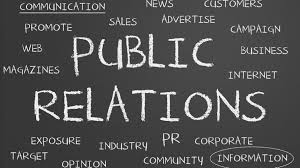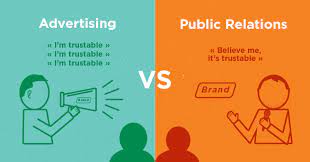Advertising and Public Relations: Harnessing the Power of Communication
In today’s fast-paced and competitive business landscape, effective communication plays a pivotal role in building successful brands and driving growth. Two key disciplines that businesses rely on to achieve their communication goals are advertising and public relations (PR). While both fields share the common objective of reaching target audiences, they employ different strategies to create impact and influence perception.
Advertising, often considered the more overt form of communication, involves paid promotional activities aimed at capturing the attention of consumers. Through various channels such as television, print media, digital platforms, and outdoor displays, advertisers strive to communicate their brand’s message in a compelling and persuasive manner. The goal is to create brand awareness, generate leads, and ultimately drive sales.
One of the primary advantages of advertising is its ability to reach a wide audience quickly. By strategically placing advertisements in high-traffic areas or during popular television shows, advertisers can ensure their message reaches a large number of potential customers. Additionally, with the rise of digital advertising, businesses can now target specific demographics based on location, interests, or online behavior. This level of precision allows for more efficient use of marketing budgets while maximizing the impact on desired audiences.
On the other hand, public relations focuses on building mutually beneficial relationships between an organization and its stakeholders. PR professionals work behind the scenes to shape public perception through strategic communication efforts. This can include media relations, crisis management, community engagement, social responsibility initiatives, and more.
Unlike advertising which involves direct promotion of products or services through paid channels, PR aims to establish credibility and trust by creating positive narratives around a brand. Through media coverage in reputable publications or by leveraging influencers’ endorsements on social media platforms, PR practitioners seek to position their clients as industry leaders or trusted authorities.
Public relations also plays a vital role in managing crises that may arise from negative publicity or unforeseen events. Skilled PR professionals are adept at crafting timely and transparent messaging to address concerns, mitigate reputational damage, and rebuild trust with stakeholders.
While advertising and public relations are distinct disciplines, they often work hand in hand to create a cohesive communication strategy. By aligning advertising campaigns with PR efforts, businesses can amplify their brand message and enhance its credibility. For example, an advertising campaign promoting a new product launch can be complemented by PR activities such as media interviews or influencer partnerships to generate buzz and validate the brand’s claims.
In today’s digital age, the lines between advertising and PR have become increasingly blurred. Social media platforms provide opportunities for businesses to engage directly with their audience, blurring traditional boundaries between paid advertising and organic content. This shift has given rise to influencer marketing, where brands collaborate with individuals who have large online followings to promote their products or services in a more authentic and relatable way.
In conclusion, both advertising and public relations are integral components of a comprehensive communication strategy. While advertising focuses on paid promotional activities to capture attention and drive sales, public relations aims to build relationships, shape perceptions, and manage reputation. By harnessing the power of both disciplines strategically, businesses can effectively communicate their brand message, establish credibility, and ultimately achieve their communication goals in today’s dynamic marketplace.
9 Essential Tips for Effective Advertising and Public Relations in the UK
- Understand your target audience – Make sure you know who you are trying to reach with your advertising and PR campaigns.
- Set goals – Have a clear idea of what you want to achieve with your campaign before you start.
- Measure success – Track the performance of your campaigns so that you can monitor their effectiveness and make adjustments if necessary.
- Use multiple channels – Consider using a variety of channels, such as social media, print media, radio and television, to reach the widest possible audience for your message.
- Focus on quality content – Make sure that all content is well-written, informative and engaging in order to capture people’s attention and encourage them to take action.
- Build relationships – Develop relationships with influencers in order to gain access to their networks and help spread the word about your campaign or product/service more effectively .
- Monitor progress regularly – Keep an eye on how things are progressing so that any issues can be addressed quickly before they become major problems .
- Stay up-to-date – Be aware of current trends in advertising and PR so that you can adjust your strategies accordingly .
- Take advantage of new technologies – Utilise new technologies such as AI or virtual reality when appropriate as these can help create more immersive experiences for customers which will increase engagement levels
Understand your target audience – Make sure you know who you are trying to reach with your advertising and PR campaigns.
Understanding Your Target Audience: The Key to Effective Advertising and PR Campaigns
When it comes to advertising and public relations (PR), one of the most crucial tips for success is understanding your target audience. Before embarking on any communication campaign, it is essential to have a clear understanding of who you are trying to reach and engage with. This knowledge forms the foundation for creating impactful and targeted messages that resonate with your intended audience.
Identifying your target audience involves more than just basic demographics like age, gender, or location. It requires a deeper understanding of their needs, preferences, behaviours, and aspirations. By delving into psychographic factors such as interests, values, and lifestyle choices, you can gain valuable insights into what motivates your audience and how to effectively communicate with them.
Why is this understanding so important? Well, imagine trying to sell a high-end luxury product to an audience that primarily seeks affordability. No matter how compelling your advertising or PR efforts may be, they will likely fall flat if they do not align with the desires and expectations of your target market. On the other hand, by tailoring your messages specifically to address their needs or desires, you can create a stronger connection and increase the likelihood of capturing their attention.
Knowing your target audience also helps in selecting the most appropriate channels for reaching them. For example, if you are targeting a younger demographic heavily engaged in social media platforms like Instagram or TikTok, investing in influencer marketing or creating engaging content for these platforms would likely yield better results than traditional print media advertisements.
Moreover, understanding your target audience allows you to craft messages that speak directly to their pain points or aspirations. By addressing their specific challenges or desires in your advertising or PR campaigns, you can position yourself as a solution provider or an ally who understands their needs. This personal connection helps build trust and credibility with your audience.
In addition to tailoring messages and selecting appropriate channels, understanding your target audience also enables you to measure the success of your campaigns more effectively. By defining clear objectives and key performance indicators (KPIs) based on your audience’s characteristics and expectations, you can track the impact and relevance of your communication efforts. This data-driven approach allows you to make informed decisions, refine your strategies, and optimize future campaigns for even better results.
In conclusion, understanding your target audience is a fundamental aspect of creating effective advertising and PR campaigns. By gaining insights into their needs, preferences, behaviours, and aspirations, you can tailor your messages to resonate with them on a deeper level. This understanding helps in selecting the right channels, crafting compelling messages, building trust, and measuring the success of your campaigns. So take the time to research and truly understand who you are trying to reach – it will undoubtedly pay off in the long run by ensuring that your communication efforts hit the mark with precision.
Set goals – Have a clear idea of what you want to achieve with your campaign before you start.
Set Goals: The Key to a Successful Advertising and Public Relations Campaign
When embarking on an advertising or public relations campaign, it is essential to have a clear idea of what you want to achieve. Setting goals is the foundation for a successful communication strategy, as it provides direction and focus throughout the entire campaign.
Before diving into the creative process or reaching out to media outlets, take the time to define your objectives. Are you aiming to increase brand awareness, generate leads, drive sales, or improve public perception? Each goal requires different strategies and tactics, so it’s crucial to be specific about what you want to accomplish.
Setting measurable goals is equally important. By establishing key performance indicators (KPIs), such as website traffic, social media engagement, or conversions, you can track progress and evaluate the effectiveness of your efforts. This data-driven approach allows for adjustments along the way and ensures that resources are allocated optimally.
Moreover, having well-defined goals helps align all stakeholders involved in the campaign. Whether it’s your internal team or external agencies, everyone should be aware of what they are working towards. This clarity fosters collaboration and enables each party to contribute effectively towards achieving the desired outcomes.
Additionally, setting goals provides a benchmark for success. Without clear objectives in place, it becomes challenging to measure whether your campaign has been successful or not. By having predetermined targets, you can assess whether you have met or exceeded expectations and celebrate milestones along the way.
Remember that goals should be realistic and attainable within the given resources and time frame. While ambitious objectives can motivate teams to push their limits, setting unattainable targets can lead to frustration and disappointment. It’s crucial to strike a balance between ambition and feasibility when defining your goals.
In conclusion, setting goals is an essential step in planning an effective advertising and public relations campaign. It provides direction, focus, and measurable outcomes that guide strategic decisions throughout the process. By clearly defining what you want to achieve and aligning all stakeholders, you can maximize the impact of your efforts and ensure that your campaign delivers the desired results. So, before you start, take the time to set goals and lay the groundwork for a successful communication strategy.
Measure Success: Tracking the Effectiveness of Your Advertising and Public Relations Campaigns
In the world of advertising and public relations, measuring success is crucial to understanding the impact of your campaigns and making informed decisions. By tracking the performance of your initiatives, you can gain valuable insights into what works and what doesn’t, enabling you to optimize your strategies for maximum effectiveness.
One of the key benefits of measuring success is the ability to monitor the return on investment (ROI) of your advertising and PR efforts. By analysing metrics such as website traffic, conversion rates, social media engagement, or media mentions, you can determine how well your campaigns are resonating with your target audience. This data allows you to allocate resources wisely and make adjustments if necessary to ensure that your communication efforts are generating tangible results.
Tracking campaign performance also helps identify areas for improvement. By closely monitoring key performance indicators (KPIs), you can pinpoint which aspects of your campaigns are underperforming or failing to meet expectations. For instance, if a particular advertising channel is not delivering the desired results, you can reallocate budget towards more effective channels or adjust your messaging to better resonate with your audience.
Moreover, measuring success provides an opportunity for continuous learning and growth. By analyzing data and identifying patterns over time, you can gain valuable insights into consumer behaviour, market trends, and industry dynamics. This knowledge allows you to refine your strategies, stay ahead of the competition, and adapt to changing market conditions.
It’s worth noting that measuring success is not a one-time task but rather an ongoing process. Regularly monitoring campaign performance enables you to detect any deviations from expected outcomes early on. This proactive approach empowers you to make timely adjustments or course corrections before any negative impact becomes significant.
In today’s digital age, there are numerous tools available for tracking campaign performance across various channels. Website analytics platforms like Google Analytics provide detailed insights into website traffic sources, user behaviour on-site, and conversion rates. Social media management tools offer metrics on engagement, reach, and audience demographics. Media monitoring services help you keep track of media mentions, sentiment analysis, and share of voice in the market.
In conclusion, measuring the success of your advertising and public relations campaigns is essential for effective decision-making and continuous improvement. By tracking campaign performance and analysing relevant data, you can gain valuable insights into what is working well and what needs adjustment. This enables you to allocate resources effectively, refine your strategies, and ultimately achieve your communication goals in a dynamic and competitive marketplace.
Use Multiple Channels: Reaching a Diverse Audience through Advertising and Public Relations
In the ever-evolving world of communication, it is crucial to employ a multi-channel approach when it comes to advertising and public relations. By utilising a variety of channels, such as social media, print media, radio, and television, businesses can effectively reach a wide and diverse audience with their message.
One of the key advantages of using multiple channels is the ability to cater to different preferences and consumption habits. While some individuals may spend hours scrolling through social media feeds, others may still rely on traditional print media or tune in to their favourite radio station. By diversifying your communication efforts across various channels, you can ensure that your message reaches people wherever they are.
Social media platforms have become powerful tools for both advertising and public relations. With billions of active users worldwide, platforms like Facebook, Instagram, Twitter, LinkedIn, and YouTube offer immense potential for businesses to engage with their target audience. These platforms allow for highly targeted advertising campaigns based on demographics, interests, and online behaviour. Moreover, they provide an opportunity for businesses to share engaging content organically and interact directly with customers through comments and messages.
Print media remains influential despite the rise of digital platforms. Newspapers and magazines continue to attract readers who value tangible publications that provide in-depth analysis or leisurely reading experiences. By placing advertisements in print publications relevant to your target market or securing editorial coverage through PR efforts, you can tap into a segment of the population that prefers traditional media consumption.
Radio has long been a trusted companion for many individuals during commutes or daily routines. Leveraging this medium allows businesses to reach listeners who are attentive and engaged. Radio advertisements can be particularly effective when targeting local audiences or promoting time-sensitive offers.
Television remains a dominant force in advertising due to its ability to captivate viewers with audio-visual content. Television ads have the advantage of reaching large audiences simultaneously during popular programmes or events. Additionally, the emergence of streaming services has opened up new opportunities for targeted advertising based on viewers’ preferences and viewing habits.
By using multiple channels, businesses can maximise their reach and increase the chances of their message resonating with different segments of the population. Each channel offers unique strengths and advantages, allowing for a comprehensive and holistic communication strategy.
However, it is important to ensure that the message remains consistent across all channels. Maintaining a cohesive brand identity and voice helps build recognition and trust among consumers. By integrating messaging strategies across various channels, businesses can create a unified brand experience that reinforces key messages and values.
In conclusion, employing a multi-channel approach in advertising and public relations is vital to effectively reach a diverse audience. By utilising social media, print media, radio, television, and other relevant platforms, businesses can tap into different consumer preferences and consumption habits. Remember to maintain consistency in messaging while adapting to each channel’s unique strengths. By doing so, you can maximise your reach and effectively communicate your message to the widest possible audience.
Focus on quality content – Make sure that all content is well-written, informative and engaging in order to capture people’s attention and encourage them to take action.
Focus on Quality Content: Engaging Audiences through Compelling Communication
In the ever-evolving world of advertising and public relations, one timeless tip stands out: focus on quality content. In a digital landscape saturated with information, capturing people’s attention and encouraging them to take action requires content that is well-written, informative, and engaging.
First and foremost, quality content is about crafting messages that resonate with your target audience. Understanding their needs, desires, and pain points allows you to create content that speaks directly to them. Whether it’s a blog post, social media update, press release, or advertisement, every piece of content should be tailored to deliver value and relevance.
Well-written content not only captures attention but also maintains it. Clear and concise language helps convey information effectively while avoiding confusion or misinterpretation. Grammar and spelling errors can undermine credibility, so proofreading is essential to ensure professionalism.
Informative content provides valuable insights or knowledge to your audience. It positions your brand as a trusted source of information in your industry. By offering helpful tips, sharing industry trends or explaining complex concepts in a simplified manner, you establish yourself as an authority figure that people can rely on.
However, quality content goes beyond just providing information; it also needs to be engaging. People are bombarded with countless messages every day. To stand out from the crowd, your content must captivate their attention and evoke an emotional response. Use storytelling techniques, compelling visuals, or interactive elements to make your content memorable and shareable.
Moreover, quality content should encourage people to take action. Whether it’s signing up for a newsletter, making a purchase, sharing the content with others or engaging in conversation through comments or social media interactions – every piece of content should have a clear call-to-action that motivates your audience to act upon their interest.
In today’s digital landscape where consumers have become more discerning than ever before – valuing authenticity and meaningful experiences – focusing on quality content is paramount. It helps build trust, credibility, and a loyal following for your brand.
Remember, quality content is an ongoing commitment. Regularly updating and refreshing your content ensures that it remains relevant and aligns with the evolving needs of your audience. Monitor feedback, engage in conversations, and adapt your content strategy accordingly to continuously improve and deliver value to your audience.
In conclusion, by prioritizing well-written, informative, and engaging content, you can capture people’s attention and encourage them to take action. Quality content builds trust, establishes credibility, and positions your brand as a valuable resource in the eyes of your audience. So make it a priority to invest in crafting exceptional content that resonates with your target audience – it will undoubtedly pay dividends in the long run.
Build relationships – Develop relationships with influencers in order to gain access to their networks and help spread the word about your campaign or product/service more effectively .
Build Relationships: The Power of Influencer Marketing in Advertising and Public Relations
In today’s digital age, where social media dominates the way we communicate and consume information, building relationships with influencers has become a powerful tool in the realm of advertising and public relations. Influencers are individuals who have amassed a significant following on platforms like Instagram, YouTube, or TikTok, and their opinions and recommendations hold sway over their dedicated audience. Collaborating with influencers can provide businesses with a unique opportunity to tap into their networks and effectively spread the word about their campaigns or products/services.
One of the key advantages of influencer marketing is its ability to reach highly targeted audiences. Influencers have cultivated communities around specific interests or niches, attracting followers who share those passions. By identifying influencers whose audience aligns with your target market, you can leverage their influence to promote your brand authentically. When an influencer endorses your product or service, it carries more weight than traditional advertising because it comes from a trusted source within their network.
Building relationships with influencers goes beyond simply reaching out for a one-time collaboration. It involves nurturing connections based on mutual respect and shared values. By investing time and effort into developing these relationships, you can establish long-term partnerships that benefit both parties involved.
When working with influencers, it’s crucial to ensure that they genuinely align with your brand’s values and messaging. Authenticity is key in influencer marketing; audiences can quickly detect insincerity or forced promotions. By selecting influencers who have a genuine interest in your industry or product/service category, you increase the likelihood of creating meaningful connections between your brand and their audience.
In addition to amplifying your brand message to a wider audience, collaborating with influencers also provides opportunities for creative storytelling. Influencers possess expertise in engaging content creation that resonates with their followers. By involving them in your campaigns or allowing them creative freedom to showcase your product/service organically, you tap into their creativity and unique style, resulting in content that feels genuine and relatable.
Furthermore, influencers often have a deep understanding of their audience’s preferences and behaviours. Their insights can provide valuable market research data that can inform your future advertising and PR strategies. By leveraging their expertise, you gain access to a wealth of knowledge about your target audience, allowing you to refine your messaging and tailor your approach for maximum impact.
In conclusion, building relationships with influencers is an effective way to enhance your advertising and public relations efforts. By collaborating with individuals who have established credibility within their niche, you can tap into their networks and spread the word about your campaigns or products/services more effectively. However, it’s important to approach influencer marketing with authenticity and a genuine interest in building meaningful connections. When done right, influencer marketing can be a powerful tool in reaching highly targeted audiences and driving brand awareness in today’s digital landscape.
Monitor progress regularly – Keep an eye on how things are progressing so that any issues can be addressed quickly before they become major problems .
Monitor Progress Regularly: Ensuring Success in Advertising and Public Relations
In the ever-evolving world of advertising and public relations, monitoring progress regularly is a crucial tip for achieving success. By keeping a close eye on how things are progressing, businesses can identify and address any issues swiftly before they escalate into major problems.
The landscape of communication is dynamic, with consumer preferences, market trends, and technological advancements constantly evolving. Monitoring progress allows businesses to stay agile and adapt their strategies accordingly. By regularly evaluating the effectiveness of advertising campaigns and PR initiatives, companies can make data-driven decisions to optimize their communication efforts.
Regular monitoring provides valuable insights into the performance of advertising campaigns. It allows businesses to track key metrics such as reach, engagement, conversions, and return on investment (ROI). By analysing these metrics, companies can identify which channels or tactics are delivering the desired results and which ones need adjustments or replacements. This proactive approach ensures that resources are allocated effectively, maximizing the impact of advertising efforts.
Similarly, in public relations, monitoring progress is essential for managing reputation and maintaining positive relationships with stakeholders. By keeping a pulse on media coverage, social media sentiment, and public perception of the brand or organization, PR professionals can detect any potential issues early on. This enables them to respond promptly with strategic messaging or crisis management plans to mitigate reputational damage.
Monitoring progress also allows businesses to seize opportunities for growth or improvement. By staying informed about industry trends and competitors’ activities through regular market research or media monitoring, companies can identify gaps in the market or emerging trends that they can leverage to their advantage. This proactive approach helps businesses stay ahead of the curve and maintain a competitive edge.
Moreover, regular progress monitoring fosters transparency within an organization. It enables teams to have open discussions about challenges faced during campaigns or PR initiatives. By creating an environment where feedback is encouraged and data-driven insights are shared regularly among team members, businesses can foster a culture of continuous improvement and collaboration.
To effectively monitor progress, businesses can leverage a variety of tools and techniques. These may include analytics platforms to track digital advertising metrics, media monitoring services to stay updated on brand mentions in the press, or customer feedback mechanisms such as surveys or social listening tools. By leveraging these resources, companies can gather meaningful data that informs decision-making and drives success.
In conclusion, monitoring progress regularly is a vital tip for achieving success in advertising and public relations. By keeping an eye on how things are progressing, businesses can identify any issues or opportunities early on. This enables them to address challenges promptly before they become major problems and seize opportunities for growth. With a proactive approach to monitoring progress, businesses can optimize their communication strategies, maintain positive relationships with stakeholders, and ultimately achieve their goals in the dynamic world of advertising and public relations.
Stay up-to-date – Be aware of current trends in advertising and PR so that you can adjust your strategies accordingly .
Stay up-to-date – Be aware of current trends in advertising and PR so that you can adjust your strategies accordingly.
In the ever-evolving world of advertising and public relations, staying ahead of the curve is essential to ensure your communication strategies remain effective and impactful. With new technologies, platforms, and consumer behaviors constantly emerging, it is crucial to stay up-to-date with the latest trends in advertising and PR.
By keeping a finger on the pulse of the industry, you can identify emerging trends and adapt your strategies accordingly. This allows you to leverage new opportunities, reach your target audience more effectively, and stay competitive in a rapidly changing landscape.
In the realm of advertising, staying up-to-date means being aware of emerging channels and platforms where your target audience spends their time. Traditional advertising methods may still have their place, but digital advertising has become increasingly important. Understanding the latest digital marketing trends such as influencer marketing, programmatic advertising, or interactive ad formats can help you optimize your campaigns for maximum impact.
Similarly, in the field of public relations, staying current with trends can help you shape your messaging and engage with your audience more effectively. For instance, social media has become a powerful tool for PR professionals to connect directly with their target audience. Being aware of popular social media platforms and understanding how to leverage them for brand building or crisis management can make a significant difference in your PR efforts.
Moreover, being knowledgeable about current trends also allows you to anticipate changes in consumer behavior or preferences. By understanding what captures attention or resonates with audiences at any given moment, you can tailor your messaging and creative approaches accordingly. This helps ensure that your campaigns are relevant and engaging to your target market.
Staying up-to-date doesn’t mean blindly following every trend that emerges but rather being informed so that you can make informed decisions about which strategies are most relevant for your business objectives. It’s important to assess whether a trend aligns with your brand values, target audience, and overall communication goals before incorporating it into your strategies.
To stay informed, make it a habit to regularly read industry publications, follow thought leaders and experts in the field, attend conferences or webinars, and engage in networking opportunities. By actively seeking knowledge and staying connected with the industry, you can gain valuable insights that will help you adapt your advertising and PR strategies to meet the ever-changing demands of your audience.
In summary, staying up-to-date with current trends in advertising and PR is crucial for success in today’s fast-paced business environment. By being aware of emerging channels, platforms, consumer behaviors, and creative approaches, you can adjust your strategies to effectively reach your target audience. Embrace the power of knowledge and stay ahead of the curve to ensure your advertising and PR efforts remain relevant and impactful.
Take advantage of new technologies – Utilise new technologies such as AI or virtual reality when appropriate as these can help create more immersive experiences for customers which will increase engagement levels
In today’s digital world, it is important for businesses to stay ahead of the curve and take advantage of new technologies when it comes to advertising and public relations. Artificial Intelligence (AI) and virtual reality are two examples of technologies that can be used to create more immersive experiences for customers.
AI can be used to personalise content for customers, allowing them to interact with a company in a more natural way. It can also be used to track customer behaviour and preferences, allowing companies to tailor their messaging accordingly. Virtual reality, meanwhile, has become increasingly popular in recent years as a way of engaging customers in an interactive and immersive environment. By using virtual reality, businesses can create unique experiences that will capture the attention of their target audience.
The use of new technologies such as AI and virtual reality is becoming increasingly important in advertising and public relations as it helps create more engaging experiences for customers. By taking advantage of these new technologies, businesses can increase engagement levels with their target audience and build stronger relationships with them.







